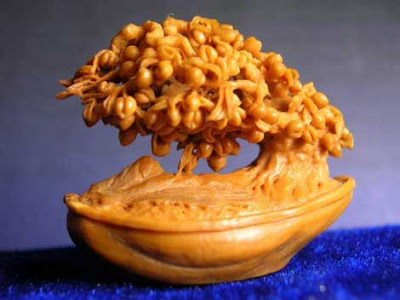The miniature folk art of fruit pit carving has been practiced in China for centuries, and is still praised for turning useless fruit stones into valuable works of art.
Nut carving (Heidao), which refers to both fruit pit and walnut carving, became popular during the Song Dynasty (960-1279), and by the time of the Ming Dynasty (1368-1644) it had become one of the most appreciated art forms in mainland China, with royalty and high-ranking officials considering it fashionable to wear carved fruit pit accessories. Even today, intricate nut sculptures like those made in Suzhou, Yangzhou, Weifang in Shandong and Guangdong Province are famous for their level of detail and unique characteristics.
Often referred to as "an uncanny work of art", fruit pit carving requires a series of skills and tools in order to produce a fine piece of art. One needs exceptional three-dimensional carving skills, a great deal of patience and most importantly, he has to be familiar with the irregular texture of a fruit pit. Peach stones are the most commonly used material for nut carving, and despite its many bumps and holes, a seasoned fruit pit carved can immediately tell if a pit is right for the artwork he has in mind.
      |
iPhone 6 Concept
-
[image: iPhone 6 Frenchsoft This Super slim iPhone 6 Concept Looks Amazing
[Photos]]
If you are a fan of TouchID fingerprint reader, you might be thrilled...
11 years ago











.jpg)